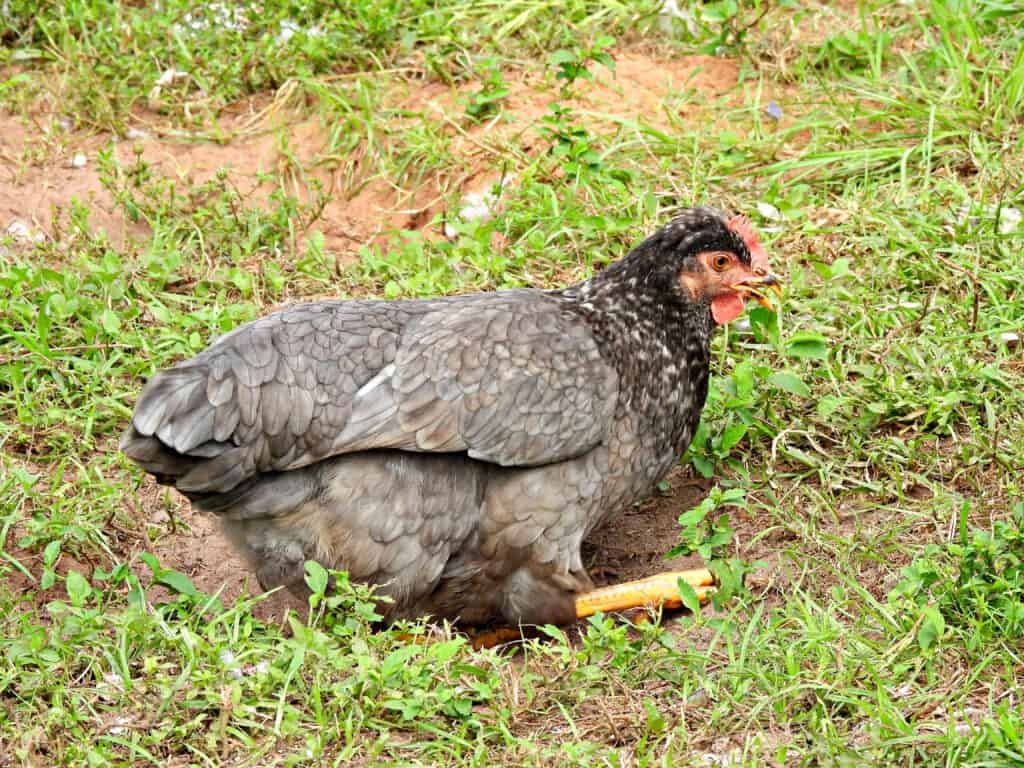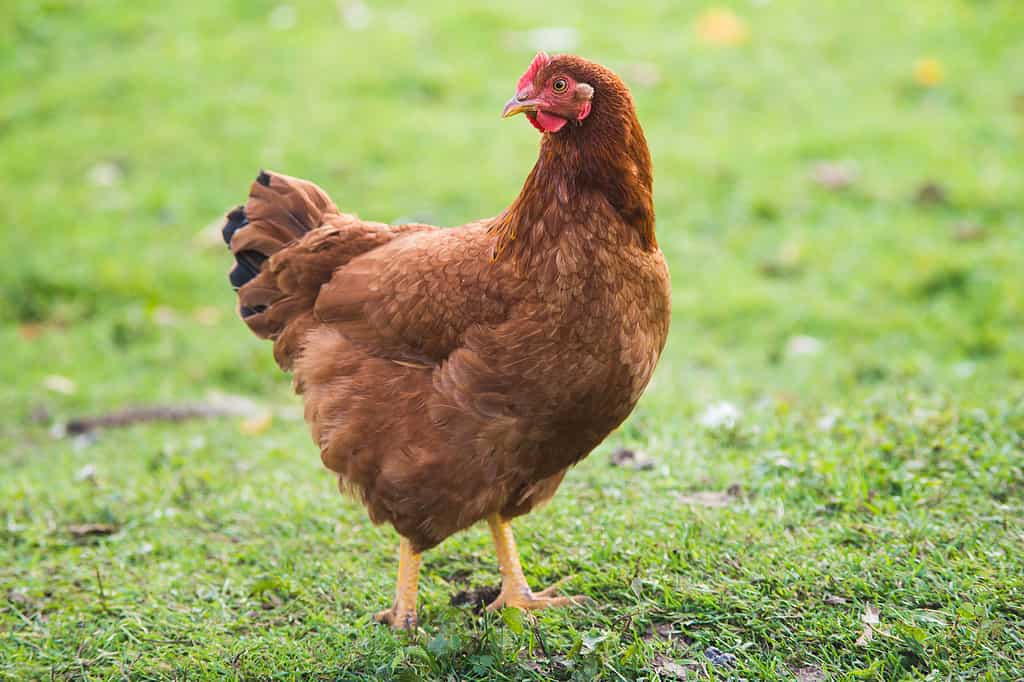The Sapphire Gem chicken has just conquered the chicken world! If you love raising low-maintenance chickens and want fresh eggs, the Sapphire Gem chicken is for you. These medium-sized animals have engaging personalities and get along well with children. First and foremost, the Sapphire Gem chicken is not an official breed, and the APA (American Poultry Association) does not acknowledge it yet. However, just because it’s an unofficial breed does not mean we can ignore the fact that it’s stunning. Although there is conflicting information about this type of chicken, almost everyone agrees that it is a new favorite.
The Sapphire Gem chicken breed, also known as the Blue Plymouth Rock or Sapphire Blue Plymouth Rock, has become popular among chicken enthusiasts. They are considered designer chickens because they are highly sought after and not widely available. However, if you wish to be a chicken aficionado, you must be aware that hens and roosters have various functions in a flock. So, how do you differentiate the male from the female Sapphire Gem chicken? This article answers that question and more!
Comparing a Male and Female Sapphire Gem Chicken
| Male | Female | |
|---|---|---|
| Color of Feathers After Hatching | – Male chicks have a white patch on their forehead or wings | – Female chicks are a solid blue color |
| Size | – At maturity, roosters will typically weigh around five pounds | – A fully developed Sapphire Gem hen weighs about four pounds |
| Comb | – The combs of roosters are bigger, brighter, and more prominent than those of females | – A hen’s comb is smaller yet just as appealing to a rooster |
| Noise | – Roosters of practically all chicken breeds, including Sapphire Gem roosters, can be noisy | – A Sapphire hen may chirp a little bit during the day, but not much more |
| Cost | – Less expensive | – More expensive as hens are naturally egg-laying |
Key Differences Between a Male and Female Sapphire Gem Chicken
The key differences between a male and a female Sapphire Gem Chicken include the color of feathers after hatching, size, comb, noise, and cost.
The Sapphire Gem chicken originated in the Czech Republic. This unofficial breed was created in that country by a breeder who crossed a Blue Plymouth rock chicken with a Barred Plymouth rock chicken. The Sapphire Gem does not breed true due to its heredity; in other words, you can breed two Sapphire Gems, but the result will not always be pure Sapphire Gem chicks. Some chicks may appear more solid blue or black rather than gray or lavender. These color variances do not make the chicks any less of a Sapphire Gem in terms of disposition or egg-laying ability, but they may result in an adult bird that is not the exact color expected.
One obvious way to tell if your chicken is a hen or a rooster is if it lays eggs. Roosters do not lay eggs, whereas hens do. On the other hand, hens do not start laying eggs until they are about 18 to 22 weeks old. Let’s further discuss each distinction to better differentiate the two species.
Male vs. Female Sapphire Gem Chicken: Color of Feathers After Hatching
Because Sapphire Gem chickens are a sex-linked variety, knowing their gender is simple if they hatch true.
Right after hatching, female Sapphire Gem chicks are often completely blue or lavender-tinged, while male chicks generally have a white patch on their heads or wings.
Once they reach maturity, both sexes have blue or lavender feathers, giving it the title ‘Sapphire Gem.’ However, hens and roosters will look slightly different from one another. A rooster can be identified by its blue feathers and a white dot on its head or wings, whereas females have blue feathers with a patch of gray or gold feathers on their necks.
Male vs. Female Sapphire Gem Chicken: Size

Male Sapphire Gem chickens weigh more than females.
©iStock.com/passion4nature
Sapphire Gems are a medium-sized breed of chicken with an alert, upright appearance. At maturity, roosters typically weigh around five pounds, while a fully developed Sapphire Gem hen weighs about four pounds.
Leg size is another feature on our list that might help you tell the difference between a rooster and a hen. Roosters’ legs are thicker than hens’. In most chicken breeds, roosters have pointed and sharp spurs on their legs, which can grow to be an inch or longer as they age.
Male vs. Female Sapphire Gem Chicken: Comb
Sapphire Gem chickens are attractive and will offer visual appeal to your flocks. Their dazzling display of full combs is highly eye-catching, and this also functions as an external organ, one of which is to control body temperature. Roosters and hens both have combs. The rooster’s comb aids in enticing a mate and is large and conspicuous, demonstrating to females that they can produce healthy offspring. A hen’s comb is smaller but just as appealing as a rooster’s.
To prevent their combs from falling off near the end of the season, a Sapphire Gem chicken, like other single-combed breeds, should be protected from frostbite during the winter months.
Male vs. Female Sapphire Gem Chicken: Noise

Although Sapphire Gem chickens are hardly noisy, males make some sounds early in the morning.
©iStock.com/passion4nature
Almost all chicken breeds, including Sapphire Gem roosters, can be rather noisy. Fortunately, Sapphire Gem chickens are rarely raucous and hardly make any noise at all. However, if you have a Sapphire Gem chicken rooster, you should expect some sounds in the early morning, which can sometimes irritate you and your neighbors. A Sapphire hen may chirp a little during the day, but not much more.
Male vs. Female Sapphire Gem Chicken: Cost

Male Saphhire Gem chickens are less expensive than females.
©iStock.com/passion4nature
When purchasing chicks, like with most breeds, males are less expensive than females, and chickens that have not been sexed will be priced in the middle. You could expect to spend around $3 and $5 for each chick, though if you buy in bulk, the price can be even lower.
What Are The Most Common Types of Egg-Laying Chickens?

Rhode Island Reds have a long lifespan for a chicken.
©Nadanka/iStock via Getty Images
- Leghorns – These energetic birds are white, and they can lay up to 250 large white eggs a year.
- Rhode Island Reds – These chickens are the most popular type of egg-laying chicken, and they lay up to 250 large brown eggs a year.
- Araucanas – This breed is known for its blue eggs, but it also lays white eggs. It can produce around 200 medium-sized eggs a year.
- Australorps – These chickens are black with some other colors mixed in, and they can lay up to 280 light brown or tinted eggs a year.
- Plymouth Rocks – These chickens are a popular dual-purpose breed, producing up to 200 large brown eggs per year.
- Orpingtons – This breed is known for its docile nature and can lay around 250 medium to large light-brown eggs annually.
- Sussex – This breed is another dual-purpose option that lays up to 300 large brown eggs each year.
Ultimately, the type of chicken you choose will depend on your needs. When it comes to choosing your egg-laying chickens, there are several factors you should consider. How many eggs do you need each year? What color of egg do you want? Do you want a dual-purpose bird that can be used for both meat and eggs? It’s important to research the breed thoroughly before purchasing chickens.
The photo featured at the top of this post is ©
Sources
- Know Your Chickens / Accessed September 7, 2022
- Rural Living Today / Accessed September 7, 2022
- Backyard Chicken Chatter / Accessed September 7, 2022
Thank you for reading! Have some feedback for us? Contact the AZ Animals editorial team.







